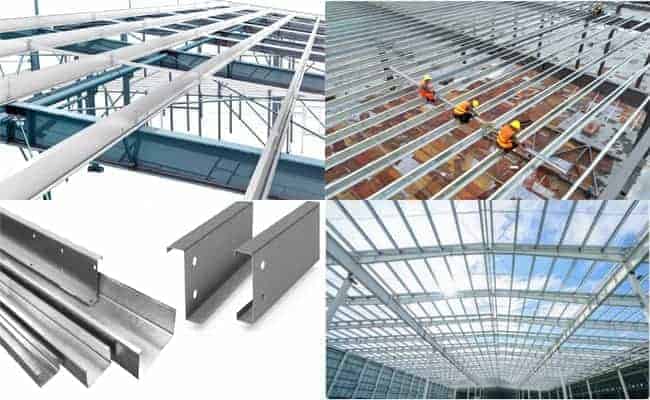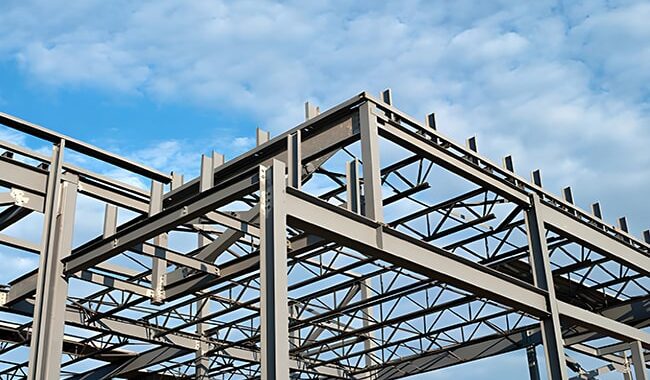A steel frame is a structure made of steel, usually connected by welding, bolting, or riveting steel beams, columns, bracing,…
In addition to the main structures, such as steel beams and columns, the most essential thing in a steel structure building is the purlins. Steel structure purlins are horizontal members that connect roofs and walls; they can be horizontal or inclined, depending on the needs of the building. It is a connector whose primary function is to connect the wall and roof panels to the essential components. Purlins are transverse bending (usually two-way bending) members and are generally designed as single-span supported purlins. Commonly used purlins include solid web type and light steel truss type.

Types of steel structure purlins:
Steel structure purlins include C-type, Z-type, and double C-type purlins.
Features of C-shaped purlin:
The cold bending of a hot coil plate makes c-shaped steel. It has a thin wall, is lightweight, has excellent cross-sectional performance, and has high strength. A forming machine rolls the C-shaped steel. The product has a smooth surface and high dimensional accuracy. The material is Q195-345. C-type purlins are suitable for roofs with gentle slopes and short spacing.
Features of Z-shaped purlin:
In addition to its excellent properties, such as high strength and saving steel, Z-shaped steel is straightforward and fast to install and is made of Q195-345. Z-shaped steel is mainly used for purlins in buildings of steel structures, especially on large-slope roofs.
Purlins include roof and wall purlins, generally using C-shaped and Z-shaped steel. However, due to actual needs, C-shaped steel cannot meet the load-bearing requirements, and H-shaped steel is used. This H-shaped steel is called high-frequency H-shaped steel.
If the distance is 8 or 12 meters, then Z-shaped or C-shaped double-buckle purlins should be used.
If the bay exceeds 10 meters, it is best to use type C 300. Only in this way can the best toughness be achieved.
Purlins are divided into principal and secondary purlins according to their functions. The main purlins are connected to the columns and beams of the roof and exterior wall structures, and the secondary purlins are used to connect the roof panels and exterior wall panels to the basic structure.
What are the main functions of steel structure purlins?
1. Support and Stabilize Structure
Steel Structure Purlins connect the roof and walls and bear the gravity and other loads from the superstructure. Purlins ensure the stability and safety of the structure by transferring these loads to the foundation of the building. In addition, purlins can also disperse loads, reduce stress on the system, and improve the overall performance of the structure.
2. Share the load and reduce vibration.
Steel Purlins also play a vital role in load sharing in steel structures. They distribute the loads on the roof and walls evenly across the purlins, reducing concentrated forces on the system. This helps reduce stress on the structure and improves its load-bearing capacity and seismic performance. In addition, purlins can reduce structural vibrations and provide a more stable building environment.
3. Connect and fix other components.
Purlins also play a role in connecting and fixing other components in steel structures. They are usually connected to roof beams, wall beams, and other structures and are fixed together by bolts, welding, etc. This connection and fixation can enhance the overall rigidity and stability of the structure and ensure the safety and reliability of the structure. At the same time, purlins can also provide a certain degree of flexibility to adapt to structural deformation and torsion, ensuring the integrity and stability of the structure.
4. Provide installation and maintenance convenience.
Purlins also play a role in facilitating the installation and maintenance of steel structures. They usually adopt standardized design and manufacturing and can be processed and prefabricated according to the needs of the building, reducing the construction period and cost. In addition, installing and removing purlins is relatively simple, which can improve construction efficiency and reduce labor costs. At the same time, purlins are relatively easy to maintain and repair, reducing maintenance costs and extending the structure’s service life.














